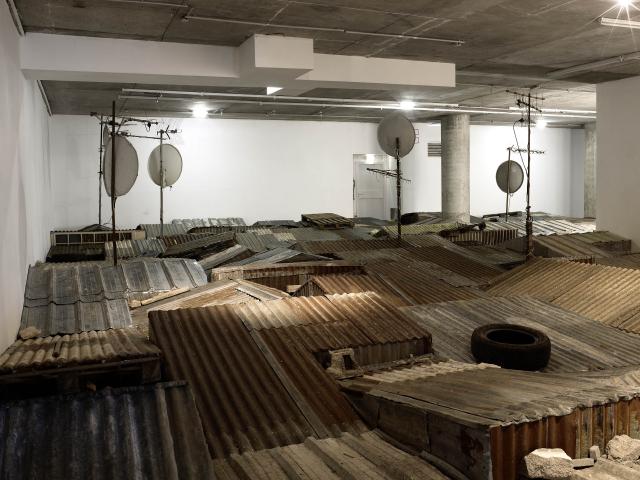KADER ATTIA
Born 1970 in Paris, France. Lives and works in Berlin, Germany.

Kader Attia, Kasbah, 2009, wood, corrugated iron, tv antennas, satellite dishes and found materials, dimensions variable. Courtesy the artist; Centre de Création Contemporaine de Tours, France; Galerie Christian Nagel, Cologne and Berlin; and Galerie Krinzinger, Vienna. Photograph: François Fernandez
Kader Attia was born to Algerian parents in the Paris suburb of Dugny in 1970. His upbringing in a North African immigrant community, studies in Paris and Barcelona, and three years spent in Congo-Brazzaville and Kinshasa have informed a practice that explores geography, history, gender, politics and philosophy. His works engage with important world issues through a poetic negotiation of the experiences of living within and between different cultures.
His sculptures, installations, videos and photographs focus on discrepancies between how people actually live and how contemporary politicians present the world, slipping effortlessly between media with the sensibility of both a poet and an activist. In an early slide installation, La Piste d’atterrissage (1997–99), Attia documents an immigrant Algerian transsexual community in Paris. The title translates to ‘The Landing Strip’ and refers to an area where many transsexuals ‘landed’ following their persecution during the Algerian Civil War. Refused refugee status in France, they were forced to prostitute themselves on the outskirts of the city. Attia presents their stories with respect, acknowledging the complexities of living between cultures and genders.
In one of his best known works, Flying Rats (2005), figures of children moulded from birdseed are slowly eaten away by pigeons. The ‘children’ sit, interact and play in their birdcage playground, representing childhood nostalgia and corresponding states of vulnerability – an allegorical scenario conjuring a fear of the powers and predators that shadow everyday life. In a series Attia produced about the shortage of water, he dealt with this most precious of resources, its place in the political consciousness of the Middle East, and its precarious future. In Untitled (water disparition) (2009), he displays six-packs of large water bottles from different Arab countries, complete with Arab script on the packaging. With the bottles removed, these plastic wrappers become evocative, minimalist sculptures – like empty cells where water should be, but is not.
For the 17th Biennale of Sydney, Attia will fill one of the cavernous spaces in Cockatoo Island’s Turbine Hall with rooftop materials collected from improvised dwellings and shanty towns found on the fringes of cities across the world. In this work, titled Kasbah, he presents a microcosm of contemporary reality. The series of shanty town roofs collected by the artist are installed at different angles to make a 350-square-metre patchwork of corrugated iron and other scrap materials. As in the case of Minimal objects of the mid-1960s made by such artists as Carl Andre, visitors are invited to walk across them; but, unlike the earlier work that was flat, the difficulty of making each tentative step over this uneven, variegated surface provokes a consideration of the successes and failures of the globalised economy and of the human ability to wrest a liveable existence from nothing. Engaging with it, one not only becomes part of the sculpture but also implicitly part of the economic and power matrix that creates these shanty towns. Stomping over them, one confronts the political reality of global hierarchies, gaining a different view about how the world really is – the reality that includes worldwide poverty and profound inequality.
puma.creative Mobility Award recipient.
Selected Solo Exhibitions
2009 ‘Kasbah’, Centre de Création Contemporaine de Tours, Tours, France 2009 ‘As a Fold, Horizon is Not a Space’, Galerie Christian Nagel, Berlin, Germany 2008 ‘Black & White: Signs of Times’, Centro de Arte Contemporaneo Huarte, Huarte, Spain 2008 ‘New Works’, Henry Art Gallery, Faye G. Allen Center for the Visual Arts, University of Washington, Seattle, USA 2007 ‘Momentum’, ICA of Boston, Boston, USA
Selected Group Exhibitions
2009 ‘Integration and Resistance in the Global Era’, 10th Havana Biennale, Havana, Cuba 2009 ‘Time Out of Joint: Recall and Evocation in Recent Art’, The Kitchen, New York, USA 2009 ‘La Force de l’Art, Paris Triennale’, Le Grand Palais, Paris, France 2009 ‘Praxis, Art in Times of Uncertainty’, Thessaloniki Biennale, Thessaloniki, Greece 2009 ‘Los de Arriba y los de Abajo’, Sala de Arte Público Siqueiros, Mexico City, Mexico
Selected Bibliography
Nuit Banai, ‘Kader Attia: Centre de Création Contemporaine de Tours’, Artforum, November 2009, vol. XLVIII, no. 3, pp. 246–47
Nicholas Baume, ‘Sleeping from Memory’, Momentum, exhibition catalogue, 2007
Hannah Feldman, ‘Life on the surface of everywhere’, Black & White: Signs of Times, exhibition catalogue, Centro de Arte Contemporaneo Huarte, Spain, 2008, pp. 87–97
Courtney J. Martin, ‘Empty and Full Against the Night Sky’, Signs of Reappropriation, exhibition catalogue, SCA D, Atlanta, 2009
Octavio Zaya, ‘Between the Things and the Words’, art.es, no. 23, 2008, pp. 48–63




























